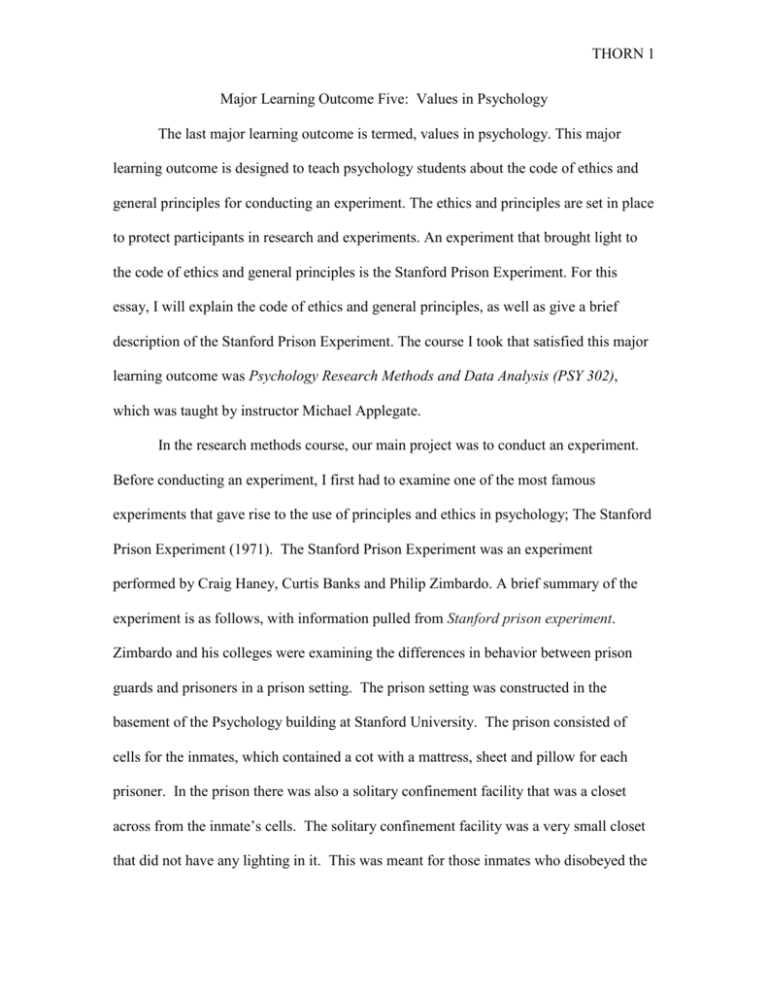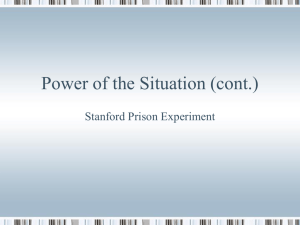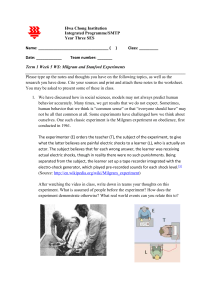Learning outcome Five_Kathleen Thorn
advertisement

THORN 1 Major Learning Outcome Five: Values in Psychology The last major learning outcome is termed, values in psychology. This major learning outcome is designed to teach psychology students about the code of ethics and general principles for conducting an experiment. The ethics and principles are set in place to protect participants in research and experiments. An experiment that brought light to the code of ethics and general principles is the Stanford Prison Experiment. For this essay, I will explain the code of ethics and general principles, as well as give a brief description of the Stanford Prison Experiment. The course I took that satisfied this major learning outcome was Psychology Research Methods and Data Analysis (PSY 302), which was taught by instructor Michael Applegate. In the research methods course, our main project was to conduct an experiment. Before conducting an experiment, I first had to examine one of the most famous experiments that gave rise to the use of principles and ethics in psychology; The Stanford Prison Experiment (1971). The Stanford Prison Experiment was an experiment performed by Craig Haney, Curtis Banks and Philip Zimbardo. A brief summary of the experiment is as follows, with information pulled from Stanford prison experiment. Zimbardo and his colleges were examining the differences in behavior between prison guards and prisoners in a prison setting. The prison setting was constructed in the basement of the Psychology building at Stanford University. The prison consisted of cells for the inmates, which contained a cot with a mattress, sheet and pillow for each prisoner. In the prison there was also a solitary confinement facility that was a closet across from the inmate’s cells. The solitary confinement facility was a very small closet that did not have any lighting in it. This was meant for those inmates who disobeyed the THORN 2 rules of the guards. In order to obtain all the video and audio recordings that were being used for data, there was a room constructed for constant recordings, equipment, as well as space for observers. The participants who were selected to play the role of a guard were given a uniform that consisted of plain khaki shirts and trousers, a whistle, a police nightstick and reflecting sunglasses, which made eye contact impossible. The prisoners’ uniform consisted of loosely fitting muslin smocks with an identification number on the front and back, as well as a chain and lock that were placed around the ankles. The prisoners were held in this prison setting 24/7, whereas the guards were allowed to go home after their shift. This experiment was intended to last two weeks, but after five participants had to be released from the experiment for depression, anxiety, rage and crying, the experiment was shut down after only six days. The Stanford Prison Experiment has had a lot of criticism due to its lack of morals. Clearly there were lines that were being crossed, both physical and emotional. The prisoners were being abused emotionally to the point of breaking. The setting in which the prisoners were being held was much worse than an actual prison. The lack of morals had the most impact with regards to the guards; the guards felt they had a higher sense of entitlement than the prisoners. The guards treated the prisoners like they were actual deviants of society, with disrespect and disgust. When in reality both the prisoners and guards were of similar socioeconomic standings, and in fact, were randomly assigned to be either a prisoner or a guard. No one person was chosen over another to be a guard or to be a prisoner. Following the review of the Stanford Prison Experiment, I was given the go-ahead to begin my research. THORN 3 In the Research Methods class, I learned what the five general principles are: beneficence and nonmaleficence, fidelity and responsibility, integrity, justice and respect for people’s rights and dignity. As Morling (2011) describes in Research Methods in Psychology: Evaluating a World of Information, beneficence and nonmaleficence are when psychologists strive to benefit those with whom they work and take care to do no harm. In their professional actions, psychologists seek to safeguard the welfare and rights of those with whom they interact professionally and other affected persons and the welfare of animal subjects of research. Fidelity and responsibility: psychologists establish relationships of trust with those with whom they work. They are aware of their professional and scientific responsibilities to society and to the specific communities in which they work. Psychologists uphold professional standards of conduct, clarify their professional roles and obligations, accept appropriate responsibility for their behavior and seek to manage conflicts of interest that could lead to exploitation or harm. Integrity: psychologists seek to promote accuracy, honesty and truthfulness in the science, teaching and practice of psychology. In these activities psychologists do not steal, cheat or engage in fraud, subterfuge or intentional misrepresentation of fact. Psychologists strive to keep their promises and to avoid unwise or unclear commitments. Justice: psychologists recognize that fairness and justice entitle all persons to access to and benefit from the contributions of psychology and to equal quality in the processes, procedures and services being conducted by psychologists. Respect for People's Rights and Dignity: psychologists respect the dignity and worth of all people, and the rights of individuals to privacy, confidentiality, and self-determination. Psychologists are aware that special THORN 4 safeguards may be necessary to protect the rights and welfare of persons or communities whose vulnerabilities impair autonomous decision-making. Morling (2011) explains, the general principles are in place to guide and inspire psychologists toward the very highest ethical ideals of the profession. General Principles, in contrast to Ethical Standards, do not represent obligations and should not form the basis for imposing sanctions. Morling (2011) stated, The Ethics Code, is intended to provide standards of professional conduct that can be applied by the American Psychological Association (APA) and by other bodies that choose to adopt them. Compliance with or violation of the Ethics Code may be admissible as evidence in some legal proceedings, depending on the circumstances. I feel the general principles and code of ethics are important not only for psychological research, but for any type of research/experiments that are being conducted, using human subjects. The Stanford Prison Experiment most boldly violated the principle of Beneficence and Nonmaleficence. Beneficence and nonmaleficence holds the experiment conductor to do no harm to its subjects. The participants of the Zimbardo’s experiment were harmed on more than one account, as well as more than one level. It is through this experiment (SPE), why psychologists are now more aware and conscious of their participants and the characteristics of their experiments. If I were to conduct a professional experiment I would be held accountable to abide by these principles. The information I gained from this course will help me flourish in my future research. THORN 5 References Morling, B. (2011). Research methods in psychology: Evaluating a world of information. New York: Norton & Company. Zimbardo, P. G. (1971). Stanford prison experiment. Stanford University.








